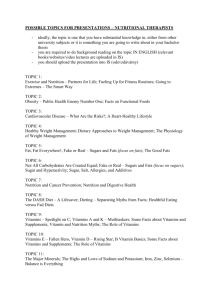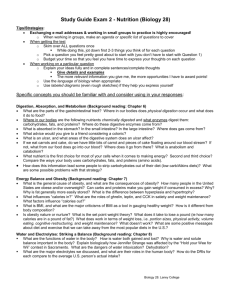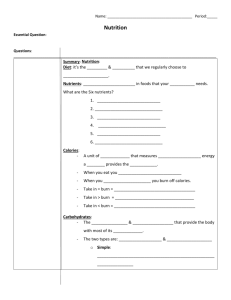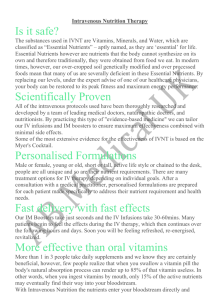Vitamins in Nutrition.doc
advertisement
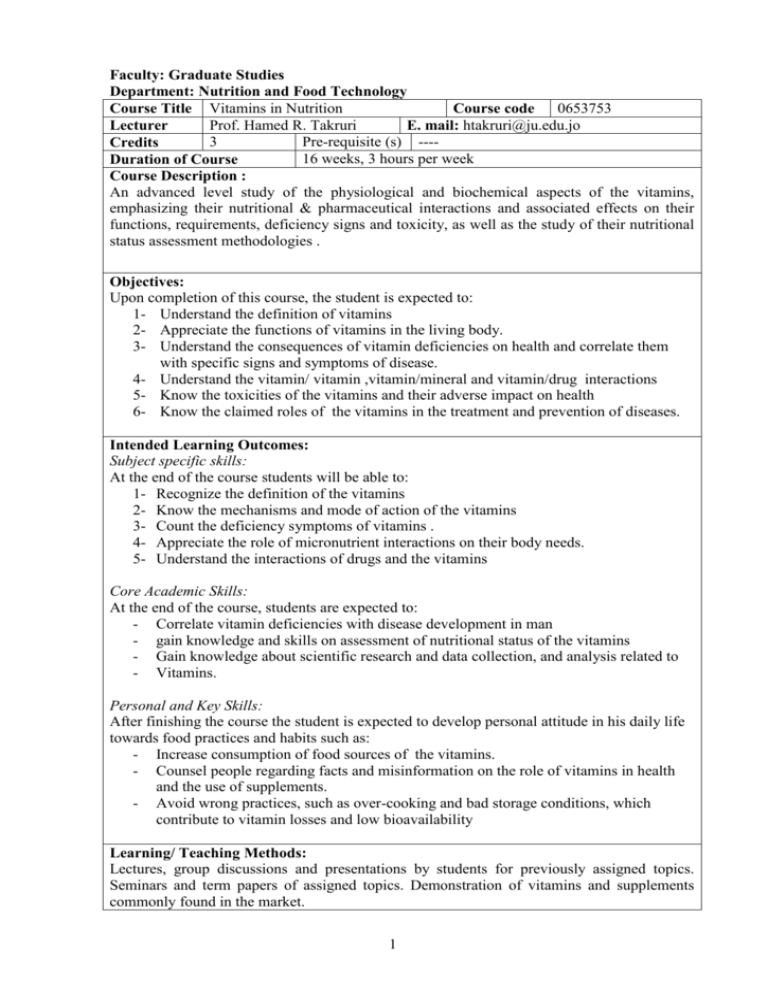
Faculty: Graduate Studies Department: Nutrition and Food Technology Course Title Vitamins in Nutrition Course code 0653753 Prof. Hamed R. Takruri E. mail: htakruri@ju.edu.jo Lecturer 3 Pre-requisite (s) ---Credits 16 weeks, 3 hours per week Duration of Course Course Description : An advanced level study of the physiological and biochemical aspects of the vitamins, emphasizing their nutritional & pharmaceutical interactions and associated effects on their functions, requirements, deficiency signs and toxicity, as well as the study of their nutritional status assessment methodologies . Objectives: Upon completion of this course, the student is expected to: 1- Understand the definition of vitamins 2- Appreciate the functions of vitamins in the living body. 3- Understand the consequences of vitamin deficiencies on health and correlate them with specific signs and symptoms of disease. 4- Understand the vitamin/ vitamin ,vitamin/mineral and vitamin/drug interactions 5- Know the toxicities of the vitamins and their adverse impact on health 6- Know the claimed roles of the vitamins in the treatment and prevention of diseases. Intended Learning Outcomes: Subject specific skills: At the end of the course students will be able to: 1- Recognize the definition of the vitamins 2- Know the mechanisms and mode of action of the vitamins 3- Count the deficiency symptoms of vitamins . 4- Appreciate the role of micronutrient interactions on their body needs. 5- Understand the interactions of drugs and the vitamins Core Academic Skills: At the end of the course, students are expected to: - Correlate vitamin deficiencies with disease development in man - gain knowledge and skills on assessment of nutritional status of the vitamins - Gain knowledge about scientific research and data collection, and analysis related to - Vitamins. Personal and Key Skills: After finishing the course the student is expected to develop personal attitude in his daily life towards food practices and habits such as: - Increase consumption of food sources of the vitamins. - Counsel people regarding facts and misinformation on the role of vitamins in health and the use of supplements. - Avoid wrong practices, such as over-cooking and bad storage conditions, which contribute to vitamin losses and low bioavailability Learning/ Teaching Methods: Lectures, group discussions and presentations by students for previously assigned topics. Seminars and term papers of assigned topics. Demonstration of vitamins and supplements commonly found in the market. 1 Assignments: Each student is assigned a topic in which he/she explores literature through use of library and internet, then write- a report which is presented and discussed in the classroom. Assessment: Midterm Exam 30 % Course Project & Student Participation 15 % Drop Quizzes 15 % Final Exam 40 % Total 100 % Syllabus Plan Week Topic 1&2 * Introduction to the course * Micronutrients(Vitamins and Minerals): * Nomenclature, History, Classifications of the vitamins * Factors affecting General functions, Bioavailability and Requirement Fat-Soluble Vitamins 3&4 - Vitamin A (Retionl) 5 - Vitamin D (Calciferols) 6 - Vitamin E & K (Tocopherols and Quinones) 7-11 7 Hours Water – Soluble Vitamins - Thiamin (B1), Riboflavin (B2) 8,9 - Niacin, pantothenic acid pyridoxine (B6), Biotin Midterm Exam 10,11 - Folic acid, cobalamin (B12) & Ascorbic acid (vitamin C) 12 - Vitamin -like substances 13 - Vitamin interactions: Vitamin-vitamin, vitamin drug & nutrition vitamin-mineral interactions. 14 -Assessment of nutritional status of vitamin 15 - Micronutrient therapy: using the vitamins a) Vitamins and cancer b) Other therapeutic potentials c) Vitamin abuse and safety considerations FINAL EXAM 2 Comments References: 1. Combs,G.F (1998) The Vitamins : Fundamental Aspects in nutrition and Health, 2nd edn., Academic Press,Newyork 2. Basu, T.K.& Dickerson, J.W.(1996). Vitamins in Human Health and Disease CAB International, Guildford. 3. Tolonen,M.(1990) Vitamins and Minerals in Health and Nutrition.Elias Horwood,New York. 4.Marks,J.(1985) A guide to the Vitamins. MTP Press Ltd.,Lancaster. 5. Gyorgy,.P.&Pearson W.N.(or Sebrell 7 Harris edn.)(1967). The Vitamins,,Vol. I to VII. Academic Press, New York. 6. Augustin, J. et al. (1985). Methods of Vitamin Assay, 4th ed. J. Wiley and Sons, New York. 7. Recent advances in the Vitamins : Selected papers and reviews Related Websites: Food and Nutrition Information Center: www.nal.usda.gov/fnic. Centers for Disease Control (CDC): www.cdc.gov. www.nutritiongate.com USDA's Gateway to Nutrition Information: www.nutrition.gov. Food and Nutrition Service: www. fns.usda.gov/fns. 3 Faculty of Agriculture Dept. Nutrition and Food Technology Vitamin in Nutrition (6058753 Dr. H.R. Takruri Fall 2005 Course Project in Vitamins 1. Vitamin fortification programs in Jordan. 2. Carotenes as precursors of vitamin A 3. Vitamin deficiencies in the Arab Middle East region 4. Vitamin supplements for the school children in Jordan 5. Role of the vitamins in hemoglobin formation 6. Vitamin C requirements Determination in Smokers and Nonsmokers 7. Vitamin antagonists 8. Vitamin A and mineral interactions 9. Vitamin A consumption and the risk for osteoporotic fracture 10. Folic acid deficiency: relation with detect and cardiovaseuber disease 11. Vitamin mega doses: potential hazards 12. Tocopherol content in vegetable oils: Forms and coverage of requirements 13. Folic acid-vitamin B12 interations 4


